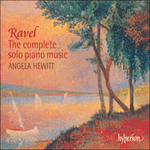No clearer example can be found of Ravel’s determination to avoid repeating himself than his
Valses nobles et sentimentales, following on the atmospherics (themselves differentiated) of
Gaspard and
Ma mère l’oye for piano duet. Here the style, as he said, ‘is simpler and clearer, in which the harmony is harder and the lines of the music are made to show up’. The epigraph at the head of the score, ‘the delightful and ever novel pleasure of a pointless occupation’, suggests that the notes provide their own rationale; but the Henri de Régnier novel from which the quotation comes deals with a young man’s amorous adventures, so, as often with Ravel, there is a tension between strict form and unbounded emotion. In coaching the work, he insisted on the cross rhythms being brought out, and Vlado Perlemuter remembered: ‘I had never seen his eyes so bright—he was so determined on being understood.’ After the seven waltzes, the Epilogue recalls various themes, and here for the first and only time the music is enveloped in a nostalgic haze. Louis Aubert gave the first performance on 9 May 1911 in a concert where the composers’ names were withheld until the end and the audience was asked to guess them. Some guessed Ravel, some Satie and Kodály, and some condemned the
Valses as unmusical and cacophonous. Certainly they represented a new Ravel.
from notes by Roger Nichols © 2011
On ne peut trouver d’exemple plus clair de la détermination de Ravel à éviter de se répéter que ses
Valses nobles et sentimentales, qui prolongent l’ambiance (elle-même différenciée) de
Gaspard et de
Ma mère l’oye pour piano à quatre mains. Ici, comme le dit Ravel, «une écriture nettement plus clarifiée, qui durcit l’harmonie et accuse les reliefs de la musique». En tête de la partition, l’épigraphe, «le plaisir délicieux et toujours nouveau d’une occupation inutile», suggère que les notes trouvent leur propre logique; mais le roman d’Henri de Régnier dont provient la citation parle des aventures amoureuses d’un jeune homme et il y a donc, comme si souvent chez Ravel, une tension entre la forme stricte et l’émotion démesurée; en faisant travailler cette œuvre, Ravel a insisté pour que les contre-rythmes ressortent et Vlado Perlemuter a déclaré: «Je n’avais jamais vu tant d’acuité dans son regard, il y avait chez lui un tel désir d’être compris.» Après les sept valses, l’Épilogue rappelle divers thèmes et ici, pour la première et unique fois, la musique est enveloppée dans une brume nostalgique. Louis Aubert en a donné la création le 9 mai 1911 dans un concert où les noms des compositeurs n’ont été divulgués qu’à la fin et où l’auditoire devait les deviner. Certains ont avancé le nom de Ravel, certains Satie et Kodály, et certains ont accusé les
Valses nobles d’être discordantes et cacophoniques. Il ne fait aucun doute qu’elles représentaient un nouveau Ravel.
extrait des notes rédigées par Roger Nichols © 2011
Français: Marie-Stella Pâris
Ravels Entschlossenheit, sich nicht zu wiederholen, ist nirgendwo deutlicher zu sehen als in seinen
Valses nobles et sentimentales, die auf die (differenzierten) atmosphärischen Effekte von
Gaspard und
Ma mère l’oye für Klavierduo folgen. Hier ist der Stil, wie er selbst sagte, „deutlich klarer, er verhärtet Harmonie und unterstreicht die Konturen der Musik“. Das Epigraph zu Beginn der Partitur, „das köstliche und stets neuartige Vergnügen einer nutzlosen Beschäftigung“, deutet an, dass die Töne eine Begründung ihrer selbst sind. In Henri de Régniers Roman jedoch, aus dem dieses Zitat stammt, geht es um die amourösen Abenteuer eines jungen Mannes; wie so oft bei Ravel ergibt sich hier also eine Spannung zwischen strenger Form und unbegrenzter Emotion. Wenn seine Schüler das Stück lernten, bestand er darauf, dass die Kreuzrhythmen herausgearbeitet wurden; Vlado Perlemuter erinnerte sich: „Noch nie hatte ich eine derartige Schärfe in seinem Blick wahrgenommen—so sehr war er darauf erpicht, richtig verstanden zu werden.“ Nach den sieben Walzern erscheinen im Epilog die verschiedenen Themen noch einmal und hier ist die Musik zum ersten und einzigen Mal von einem nostalgischen Nebel umhüllt. Am 9. Mai 1911 gab Louis Aubert die Premiere; in dem Konzert wurden die Namen der Komponisten bis zum Schluss zurückgehalten und das Publikum wurde aufgefordert, sie zu erraten. Manche rieten Ravel, manche Satie und Kódaly, und manche erklärten die
Valses als unmusikalisch und misstönend. Zweifellos repräsentierten sie einen neuen Ravel.
aus dem Begleittext von Roger Nichols © 2011
Deutsch: Viola Scheffel


 Ravel: The Complete Solo Piano Music
Ravel: The Complete Solo Piano Music
